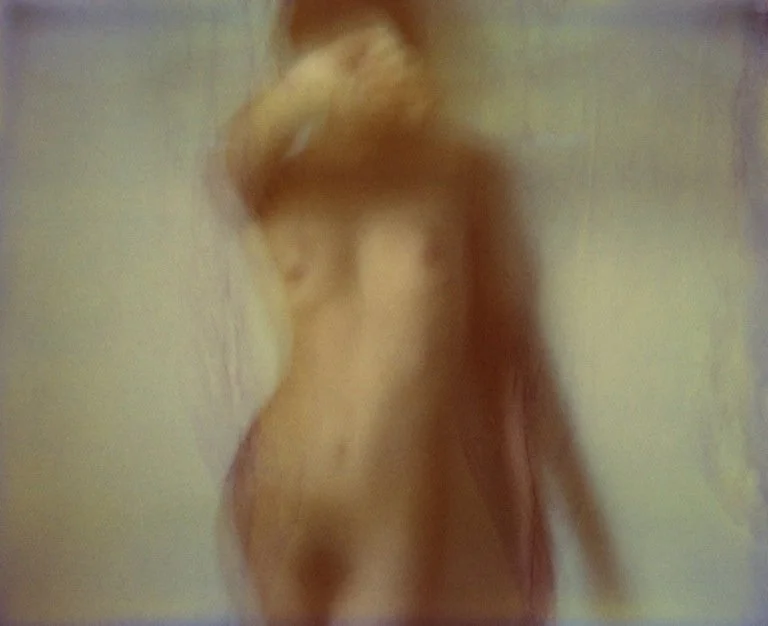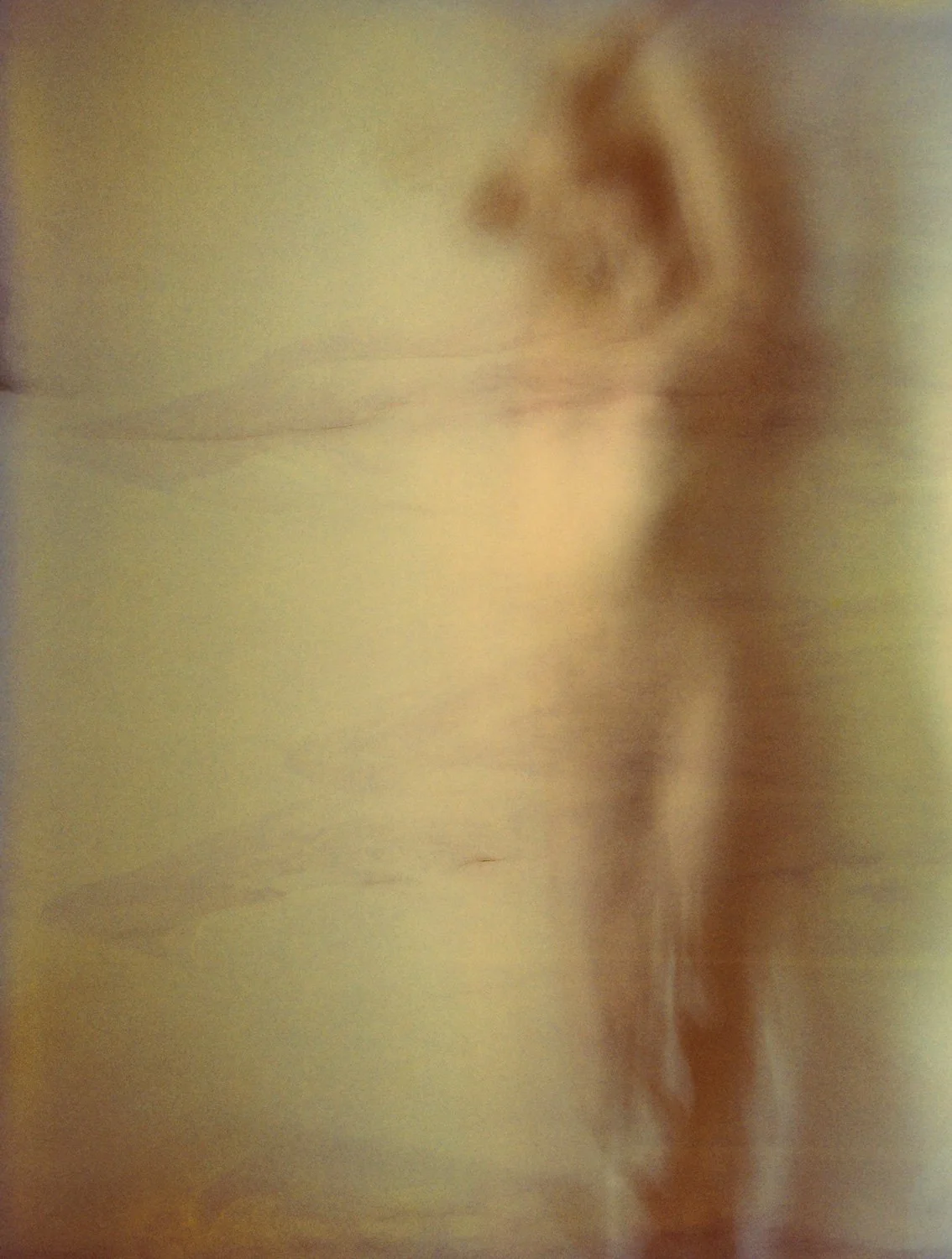Masquerade
Karl Johnson, 2011. Written for Eyemazing Magazine, Issue 04-2011.
The word "secrecy" (like the Latin phrase bearing the same meaning) is an apt description of the way viewers perceive the female form in Frank Rodick's black-and-white photographic suite entitled sub rosa. At first one's gaze seems to mysteriously circumvent the act of seeing. Then it defies empirical understanding altogether and, as though intending to secretly deceive consciousness and logic, relies on hardly more than instinct, associations, and guesswork. Via this other way of perceiving, one arrives at the kind of hallucinatory photographic statements which have made Canadian artist Rodick one of today's foremost photographic narrators and contributed to his representation in acclaimed collections on three continents.
masquerade, no. 9
©Frank Rodick, 2011
Presently there is the series entitled Masquerade, a reexamination of sub rosa and a great deal more than simply a colourized version of it. To study Masquerade is to enter into an ambiguously seductive relationship between the psyche and the body, as well as to witness an exquisite mix of darkroom and imaging techniques. Visually voluptuous and psychologically dense, Masquerade not only addresses a relationship between Rodick's earlier and more recent work; when closely observed, it points to the humanity and openness at the heart of Rodick's oeuvre. Multiple notions of time regained and remembered are expressed through what appear to be traditional "life studies", this being, perhaps, a contradiction in terms for an artist whose work consistently investigates the presence of death. At face value, the images of Masquerade—especially regarding their production details—could be considered emotional antiques. Time is literally of the essence here. The original images (sub rosa) were black-and-white gelatin silver prints completed between 1995 and 1997, and, derived from them, today's newly entitled suite of images evinces a colouring technique that reaches two time-related heights: the sometimes vibrant hues of colour lithographs found in rare books on the one hand, and the quieter effect of colourized black-and-white movie classics on the other.
Surprisingly, apart from their inviting colour scheme and romanticized sense of the body, the images of Masquerade share basic similarities with other photographs by Rodick, including the otherworldly, visceral images from the series Arena, Faithless Grottoes, and Revisitations. Here too, in Masquerade, Rodick retraces his visual steps of the past en route to making the prevalence of reveries and the act of remembering his subject matter. Not least of all, one recognizes how intensely he relies on intuition as a way to avoid any blueprinted or academic approach to image creation. Despite its compositional slimness, Masquerade displays the usual Rodickesque profusion of photographic and non-photographic sensations-a gathering together of top and bass images (creating as it were a psychological perfume) from a so-called antique shop of the emotions. In effect, the less recognizable the featured figure, the more deeply she fantastically commits herself to the viewer's memory, which in turn establishes a zone of human vision likewise a perpetual bedazzlement. As these and other aspects contribute to a sense of traditional beauty, Rodick refers to the nudes of his new suite as figures swimming in a "visual moor" or "pastel fog".
masquerade, no. 1
©Frank Rodick, 2011
The fog assumes a tremendous importance. Drawing from selected pseudo-historical writings by W.G. Sebald—a German writer who might be deemed a wizard of human reveries—Rodick points out that the fog is the befitting metaphor for life and the human condition: "[ ... ] we only see through this permeable but thick barrier, and, worse, often believing that we see clearly. But we see rather than know [ .. .]" Ultimately, a certain degree of visual impairment, concealment, or masquerade accompanies any situation that expressly concerns feelings or humanness. Also, the inevitable search for truth, even the nakedness of truth, is not achieved by way of "traditional" nudity —a simple absence of clothing. Thinking along such lines (heightened by an atmospheric, almost Proustian fog) attracts and confounds viewers in Masquerade. The woman's foggy nudity becomes, so to speak, a doorway to revelation and represents the aura of reminiscences outside of time.
masquerade, no. 10
©Frank Rodick, 2011
None of the images in Masquerade function solely as classical nudes. Hovering over the surface of each print are visual qualities comparable to estranging desire—magnets for the eyes, and they disturb as well as mesmerise the image reception. Demonstrating an unprecedented lightness for Rodick's photographic standards, the images also produce troubling regressions of reality or, as the photographer says, paraphrasing Céline, ''[ .. ] hallucinations that are more real than life." In the images from other bodies of work by Rodick, the faces of individuals often assume the form of gritty (death) masks. In the broadest sense, a similar transformation occurs in Masquerade. Cloaked in pastel fog, the model's entire body evolves to a blurred mask: a full-body mask à la Francis Bacon.
In their newer, less anxiety-ridden state as colourised nudes, the images of Masquerade are called "reworkings." More specifically, Rodick calls them reworkings of Polaroid prints and images formerly existing on corrupted Polaroid film. The conversion of the black-and-white material to colour imagery visibly leaves the series haunted by qualities from another time—but also by qualities from other media. The resulting surface qualities address painting. The positioning of the figure addresses sculpture, and the plates' frame-by-frame structuring addresses the art of filmmaking. As the photographic offspring of sub rosa, the nudes of Masquerade significantly further Rodick's work with the human figure. In the creative scheme of things, they present the female form as an unheard of crystal ball of flesh, and the drama in its shimmering "skin of glass" as overpowered by a dialogue on memory and time.
According to Rodick, reworking the images qualifies in and of itself as an important act of nostalgia. He goes on to say that " revisiting" completed images (apart from being artistically medicinal when enduring personal crisis) gives artists the unique opportunity to deepen their relationship with works that have existed in their consciousness for longer periods of time already. This links with the way art-making studies, for example, constantly marvel from anew over Picasso's reworking of the bull motif. (Apropos of Picasso, the "pastel" works of Masquerade bespeak a kind of "Rose Period" for Rodick's oeuvre.) The expressive results leave viewers wishing they could see their creator at work, assigning colours to forms and new points of interest to existing compositions. Instead, the eye has to settle for reading (imagined) meanings into images whose seductiveness has a somewhat plaintive appeal.
masquerade, no. 4
©Frank Rodick, 2011
Except for the plate in which the model poses like the male figure in Michelangelo's The Dying Slave, no other " high art" reference seems to surface. Elsewhere, 20th-century film history seeps through: the plate showing the model shielding her face with the palm of her right hand recalls the last living gesture of the victim in the shower scene of Hitchcock's film Psycho. Through more imagining, the torso subjected to a swirling effect hints at a brief survey of contemporary photography and seems to quote figurative abstractions by Andre Kertesz. For one European viewer, the sinuous torsos bring to mind expressionist dancers of the 1920s; for another they suggest a never-made still from Tarkovsky's film Andrei Rublev, taken from the scene in which a nude Bacchanalia transpires beside a lake. The point is that we rarely encounter only the image of a woman, but rather, true to Rodick's expansive art, countless references and recollections. This is how the photography of reverie works.
In light of what the viewer actually sees, however, the colouring process adds fullness to the female form and creates an unexpected warmness. In turn, Masquerade invites observation to same extent that the black-and-rust-coloured images of Revisitations—a series featuring horror-stricken faces resembling the open-mouthed victims of unspeakable experiments, hangings, and studies of real and imagined deaths—almost dare viewers to look closer. With Masquerade, Rodick shows greater tenderness towards the photographic world he usually fractures, dissects, and reshapes with foreboding areas of blackness. This time he creates a level of human enchantment, and while his signature directness prevails, there is a palpable increase of passion.
The feat of Masquerade is that it offers viewers a drama of the mind (in the guise of nudes) in which an "atmosphere of reverie and chimera" takes over. But this takeover also raises big questions. Rodick incites odd philosophical disputes tailored to artistic thinking. His colourised nudes are not per se dependent upon real life and created, as the phrase goes, "after nature." Instead, they appear created "after reverie." Lugubrious or not, these images aspire to the difficult task of giving form to the concept of the reverie. Yet how is this possible—or done at all? What does the beast of reverie look like? Does it secretly emulate the mind's twists and turns, the foggier zones of the consciousness, and the misgivings of the heart? Is reverie inspired into existence by surface qualities born of corrupt Polaroid film material, the same material serving as the starting point of the series? Is old Polaroid material and its corruption infinitely more important than one thinks? Do these materials pose the greatest question of all: Is memory a form of elevated (psychological) corruption?
masquerade, no. 11
©Frank Rodick, 2011
None of these questions are easily answered, and since Rodick's work often demonstrates a blend of unanswered questions and disturbing answers, he most likely prefers it this way. In a single gesture his photography embraces storytelling, stray biographical data, and antiquarian essays. At the same time, its artistic presence exceeds any truth founded exclusively on logic. In effect, a hard-to-explain existence is shown to viewers in a hard-to-explain manner. In Masquerade, the implied knowledge born of reverie is kept secret and contained by a female form. In this way, Rodick insinuates an ethical discussion as well. He is not arguing what is true or false, or, for that matter, what is fiction or non-fiction. Instead, forever searching and improvising, he cites the dual presence of a traditional and non-traditional truth. He combines suggested references with original sensations, and his two most indispensable tools for doing so are his own visions and instincts.
The female form presented in Rodick's Masquerade is primarily a celebration of temporality. Everything within and surrounding it is dreamlike, ephemeral, and fleeting . And the form itself—the occupant of the alternative world at large—is made of the most fleeting materials: flesh and blood. No great wisdom is needed to know that the aging (also decaying) process—a fierce sibling of the remembering process reigns over the human condition. But when accepted with feeling, and when conveyed through an individual likewise a living chimera, grasping the already known does much more than exceed humanness and the boundaries of traditional photography. In this case, it also emphasizes many of Rodick's non-photographic inspirations—concepts and ideas that he gleans from a wide variety of thinkers and writers.
The pastel-coloured woman, who stands before the viewer like a photographic Siren, lures and recalls without stopping. As she encourages the viewer's guesswork, she also renews an underlying sense of astonishment. To consider or reconsider her body's luminosity produces a strange sensation in connection with a passage by W.G. Sebald. In Sebald's The Emigrants—a book of interlocking reveries and reminiscences—a character renamed to Max Ferber relates an anecdote connected to the art of photography: In the 1930s there was a man working in a photograph lab in Manchester "whose body had absorbed so much silver in the course of a lengthy professional life that he turned into a photographic plate [ ... ] the man's face and hands turned blue in strong light, or, as one might say, developed. " On several levels, the protagonist of this series and the photographer himself seem to "develop" in Masquerade.





